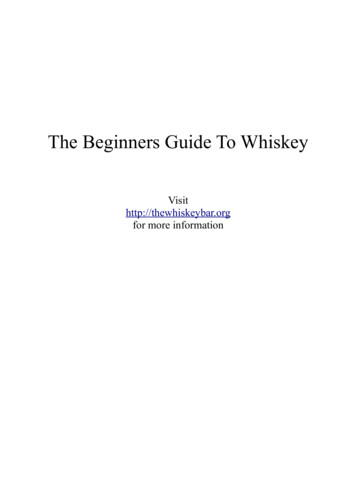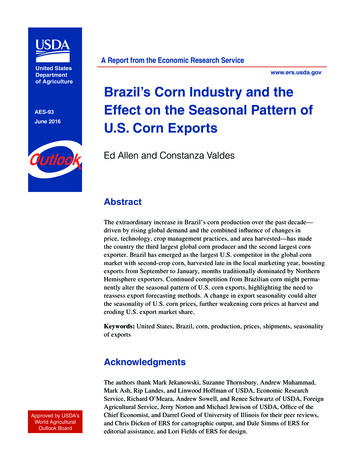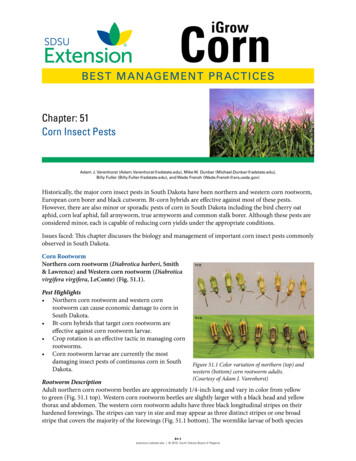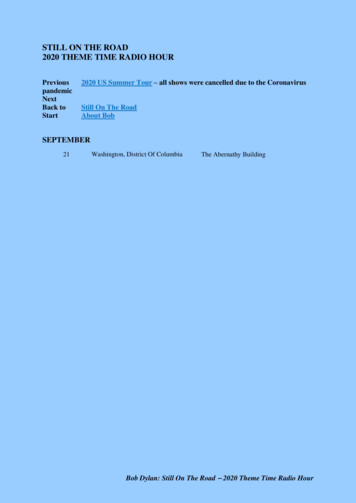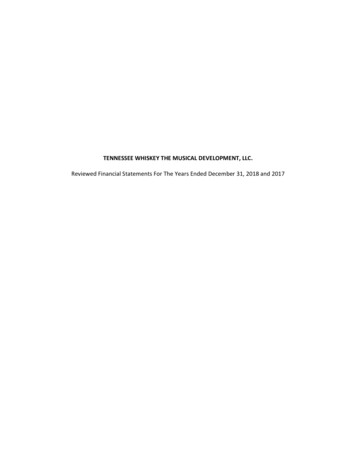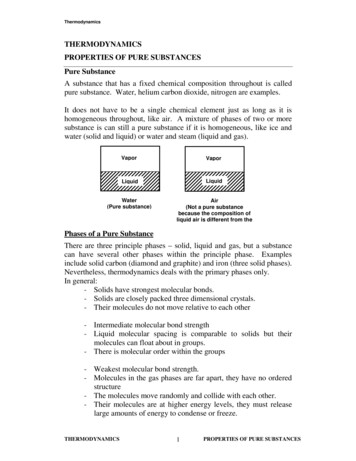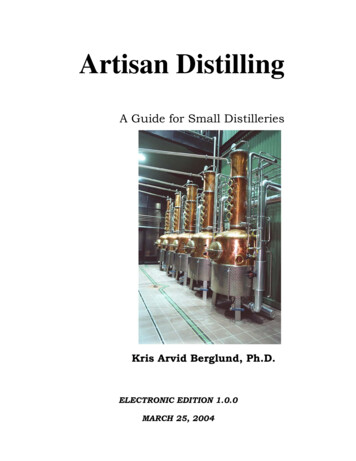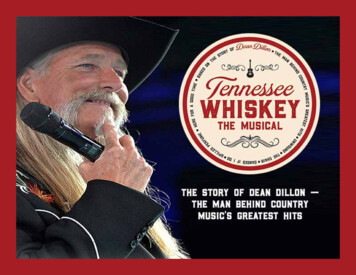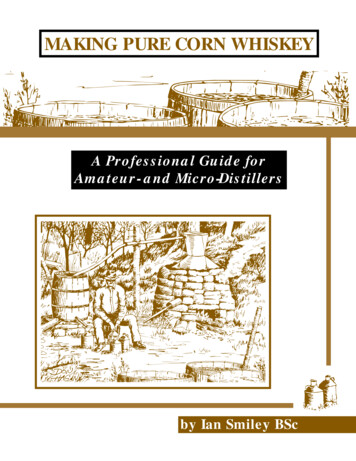
Transcription
MAKING PURE CORN WHISKEYA Professional Guide forAmateur- and Micro-Distillersby Ian Smiley BSc
FOREWORDMaking distilled spirits at home is as satisfying and rewarding as any hobby for those wholive in countries where it is legal to do so. Homebrewers and winemakers would find itparticularly interesting because it is a logical extension to their present hobbies. There arethe same mashing and fermentation stages as in brewing, but instead of drinking the brew, itis subjected to a purification process. The process is distillation, a process as fascinating asmashing and fermentation are.This is not a hobby for everyone, but no hobby is. In the first place you would only wish tobecome involved if you particularly liked the beverages it produces. Secondly, you shouldenjoy the challenge of constructing a scientific apparatus that involves a little plumbing and alittle electrical work.The satisfactions you receive will include the knowledge that you are restoring an art thatwas such a pervasive part of early Americana, and yet is all but completely lost on modernsociety. And finally, there will be the pleasure derived from making a beverage, pure cornwhiskey, which is in every way as excellent and respectable a spirit as the finest whiskies andbrandies well known to the connoisseurs of today.Copyright 1999 by Ian Smiley BScAll rights reserved. No part of this publication may bereproduced, stored in any retrieval system or transmitted in anyform or by any means without the prior written permission ofthe author.ISBN 0-9686292-0-2Printed in Canadai
DEDICATIONI dedicate this book to my wife Eleanor, whose help andsupport were invaluable to its completion.iii
TABLE OF CONTENTSChapter12345678Page NumberIntroduction 1Pure Corn Whiskey 3Beer and Wine 3Distillation – what is it? 3Simple Distillation . 4Fractional Distillation 5Whiskey, Brandy, Rum, etc. . 5Pure Corn whiskey 5The question of Legality 7The History of Corn Whiskey 11Equipment 21The Mashing Vessel 22The Fermenters 22Ancillary Equipment 22Transfer Hoses 23Immersion chiller 24Beer Stripper (Optional) 26Spirit Still 32Ingredients 47Corn 47Malt 47Water . 49Yeast 50Calcium sulphate (CaSO4) 51Gluco-amylase 5295% Sulphuric Acid (H2SO4) 52Calcium Carbonate (CaCO3) 53Mashing . 55Principles 55Mash Water 55Measuring pH . 56Adjusting pH 56Temperature 56Iodine Starch Test . 57Procedure 58Equipment 58Ingredients 58Method 58Fermentation 61Principles 61Grain Mash Fermentation . 61v
TABLE OF CONTENTS (Continued)ChapterPage NumberFermentation Times 62Specific Gravity (SG) 62Measuring SG 63Calculating Alcohol Content . 64Straining the Mash . 65Procedure 65Ingredients 65Equipment . 66Method 669 Distillation . 69Principles 69Whiskey Distillation . 71Foreshots 72Heads . 72Middle-run . 72Tails . 72Feints 72Canadian Style . 73Kentucky Style 74Tennessee Style 74Procedure 75Transferring the Mash to the Still 75Transferring the Low-wines to the Still . 75Measuring Alcohol Content 76Method 76Beer Stripping (Optional) . 76Spirit-Run . 77Flow Rate . 85Diluting 86Blending 87Storage . 8710 Summary of Procedures 89Mashing . 89Fermentation 89Beer-Stripping Distillation (Optional) 89Spirit-Run . 9011 Appendix A – Other Mashing Methods . 91Flaked Grains 91Cereal Grains 91vi
TABLE OF CONTENTS (Continued)Chapter12131415Page NumberMethod 91Equipment 91Ingredients . 91Millet . 93Appendix B – Temperature Corrections for Hydrometers . 95Appendix C – Spirit-Run Record. 97Bibliography . . 99Index . 101vii
viii
INTRODUCTIONNumerous books have been written on homebrewing and home winemaking, and some haveeven been written on home distillation to produce pure ethanol for making: gin; vodka; andessence-based spirits, but very few have been written on distillation for making whiskey onthe small scale required by hobbyists. This book has been written in an attempt to rectify thissituation, and to accommodate the recent advent of micro-distilleries and distillery pubs thatare reintroducing the art of making corn whiskey and other grain whiskies made famous bythe early frontier folk.This book should appeal to readers who have no experience with brewing or fermentation, aswell as readers who do. A basic knowledge of the simplest forms of all-grain brewing isdefinitely an asset, but not a necessity. All the mashing, fermentation, and distillationprinciples are explained in sufficient detail for the novice to learn everything they need toknow to produce the finest pure corn whiskey.Also, this book gives a brief history of corn whiskey and how it was the pivotal industry thatsustained the early settlers who opened up the American frontier. The history not only servesto remind the reader of corn whiskey, but of the rich culture, strong principles, and selfreliance that are at the foundation of American society, of which corn whiskey was such animportant part.A chapter will be devoted to the question of legality since it is highly important for everyoneto know exactly where they stand and to be comfortable with what they are doing. It ishoped that legislators and law enforcement agencies will read this chapter and, with itsperspective, be prepared to be receptive when law reformers come knocking at their doors.The temperatures in this text are quoted in oC followed by oF in brackets (e.g. 65.5oC(150oF)). Often the oC temperature will be expressed to one place of decimal. This is notdone as a matter of precision but because most of the oC temperatures quoted are translatedfrom oF, so in order to remain equivalent to the oF temperatures some will need to beexpressed to one place of decimal.Also, the temperatures quoted in the procedures are the optimum temperatures and everyeffort should be made to adhere to them. However, variations of a degree or two either waywould not result in failure of a process, but rather a slower reaction, or the production ofmore unfermentable sugars and less fermentable ones, etc. In other words, a slightly lessthan optimum result, but otherwise perfectly workable.Before getting down to the details of mashing, fermentation, and distillation a few generalobservations will be made in the next chapter on the subject of what pure corn whiskey is andof alcoholic beverages in general.1
PURE CORN WHISKEYAll alcoholic beverages are made by fermenting a sugar solution (a.k.a. a fermentablesubstrate) with yeast, a process that converts the sugar (C6H12O6) to ethanol (C2H5OH) andcarbon dioxide (CO2). Usually, one does not start with a pure sugar and water substrate, butwith fruit juices for wine, mashed grains for whiskey, molasses for rum, and many others.Regardless of the sugar source the alcohol is the same.In addition to the variations imposed by the source of sugar, the yeasts themselves and theconditions under which they are used also make their contribution to the character of the finalproduct. This is because yeasts produce small quantities of other substances known as“congeners” in addition to the main product, ethanol. It is no wonder, therefore, that theflavour, colour, aroma, and general quality of fermented beverages vary so widely.No alcoholic beverage (with the possible exception of vodka) consists simply of alcohol andwater with no other constituent present. If it did, it would be colourless, odorless, andtasteless. The colour, aroma, and flavour of beers, wines, and spirits are due to the congenerspresent.Beer and WineAlcoholic beverages can be divided into two broad categories according to whether or notthere is a distillation stage following fermentation. Beer and wine fall into the non-distilledcategory whereas whiskey, rum, brandy, gin, etc. have all been distilled. The latter are oftenreferred to as “spirits” or “hard liquor”.Wine and beer are produced by fermenting their respective substrates (i.e. fruit juices forwine, grain mash for beer) with yeast, then clearing, aging, and packaging the fermentedsubstrate as the finished wine or beer.Distillation – what is it?Distillation is simply the heating of a liquid to the boiling point followed by condensing thevapours on a cold surface back into a liquid. To remove the hardness from water it can beboiled in a kettle and the steam that is produced condensed against a cold surface to give purewater free of minerals and dissolved ions. The calcium and magnesium salts that constitutethe hardness remain behind in the kettle. Nature carries out Her own distillation in the formof rain. The sun evaporates water from the surface of lakes and oceans leaving salt andimpurities behind. Clouds form, condense, and a close approximation to pure water falls toEarth.So distillation is not a mysterious subject, nor is it threatening. It is as commonplace as arain-shower or a teakettle boiling and causing condensation on a nearby window.3
As you can imagine, the actual practice of distillation as a controlled procedure is a littlemore complicated than this and later chapters will provide an exact description of how tobuild the equipment required and the procedures involved in operating it.There are actually two different types of still, the choice of which to use depending on thelevel of purity required in the product. Traditionally, whiskey is made in one type, a pot still.It’s rather simple in design because only a moderate level of purity is required. Gin andvodka production on the other hand requires a more sophisticated type of still called afractionating still because a very high level of purity is desired. A detailed description of thetwo types will be provided in the chapter on Distillation because it is quite important for thereader to appreciate the differences.However, in this text the high-separation type of still is chosen over the traditional pot stillfor making whiskey because of the exacting control it affords over the level of separation.High-separation stills can be operated in a manner whereby they give much less thanmaximum separation, which is exactly how they are very efficiently used to make whiskey.This is covered in detail in the Distillation chapter.An advantage that falls out of this is that the high-separation still can also be used to producepure ethanol for making gin and vodka. For a well-written text on how to do this read, JohnStone Making Gin and Vodka, www.gin-vodka.com. The high-separation still designdescribed in this text can be used to make gin and vodka exactly as described in that book.Simple DistillationAs mentioned before, the fermentation of sugars derived from grapes, barley, corn, potatoes,molasses, milk or any other source produces a wide variety of chemicals, the major one beingethyl alcohol (ethanol). Minor constituents will be propyl, butyl, and amyl alcohols. Theseminor constituents are collectively called “fusel alcohols” (in the past they were called “fuseloils”, but they’re not oils they’re higher alcohols). They are responsible for the unpleasantside effects of drinking such as headaches and hangovers.When such a mixture is distilled, the first vapours to come over will be rich in the morevolatile components such as methanol and acetone. This first fraction is referred to as the“foreshots”. There is no sharp separation so, long before the foreshots are completelyexhausted, the ethanol begins to appear but is collected into a “heads” phase to buffer thetransition between the foreshots and the beverage alcohol. Later, when the ethanol phase istapering off, the “tails” begin to emerge. These are the least volatile components of themixture. At first, come the less volatile esters, and then the propyl, butyl, and amyl alcoholsknown as fusel alcohols. Thus, in a simple distillation using a pot still there are four mainfractions: the foreshots; the heads; the middle run; and the tails. The middle run is mainlyethanol with trace amounts of heads and tails, the amount of each depending on where thecut-offs are made.4
Fractional DistillationAs mentioned above, simple distillation of a mixture of liquids does not produce a clear-cutseparation of the various components. If such a separation is required it is necessary to resortto the use of a fractionating column. The theory and practice of this will be described indetail in a later chapter but a few words will be said about it here. The procedure involvesthe use of a vertical column attached to the top of the boiler. The column is packed with inertparticles such as short lengths of glass tubing known as Rashig rings, ceramic “saddles”, wiregauze, or in fact any non-reactive material with a large surface area.The vapours from the boiling liquid pass up the column, are condensed to a liquid at the top,and run back down through the packing in the column. This counter-current flow of vapourup and liquid down has the effect of producing a series of mini distillations at the surface ofeach piece of glass or metal in the column. It is equivalent to carrying out a simpledistillation in a pot still and then redistilling the product over and over again. The final resultis an almost perfect separation of the mixture into its various components, allowing each oneto be drawn off in sequence from the top of the column in the order of its boiling point.Thus, the most highly volatile components emerge first while the least volatile componentsemerge last.Whiskey, Brandy, Rum, etc.The distillation of these products is done using a pot still or a special-purpose fractionatingstill, and this effects only a crude separation of the fermented substrate into foreshots, heads,middle-run, and tails. The skill in making a palatable whiskey consists of: mashing thegrains into fermentable sugars; fermenting the mash under conditions that give rise to acertain mixture of chemicals; and, distilling the mixture and discarding a portion of the headsand a portion of the tails.The middle fraction, consisting chiefly of ethanol, will also contain the retained portion ofheads and tails (i.e. the congeners). It is these congeners that impart the characteristic flavourand aroma. At this point there is no colour. Colour is imparted by storing the spirits in oakbarrels for a number of years, a process that also modifies the chemical make-up of thewhiskey to give unique characteristics of a particular distiller.Pure Corn WhiskeyCorn whiskey is the whiskey produced by mashing corn (i.e. using malt enzymes to convertits starches to sugars), fermenting the corn mash with yeast, and distilling the fermentedmash. The mashed corn produces a particular profile of congeners that characterizes theflavour of corn whiskey.Historically, the distillers of corn whiskey took pride in the tradition of producing whiskeyand made their whiskey entirely from grain and malt. But, with the advent of the prohibition(U.S. 1921-1933) there was a surge of new distillers who had no particular attachment towhiskey making as an art or historical tradition. These new prohibition distillers became5
notorious for stretching their corn mash with sugar. Some recipes were less than 10% corn,the rest being sugar and water. While using sugar to produce a “thin mash” will produce asmuch alcohol and with much less effort, the flavour of the finished whiskey is very harsh,thin, and insipid. This prohibition type of corn-whiskey production became so prevalent thatwhiskey made from pure grain (i.e. no sugar) became a rare delicacy, and was attributed thename “pure corn whiskey”. Unfortunately, when the prohibition ended these sugar recipespersisted into the subsequent generations of corn-whiskey distilling so the traditional purecorn whiskey remained a scarce commodity.Note: Commercial whiskey producers are bound by law to use all grain in their mashes, andno spirit made with sugar can be called “whiskey”.For a more detailed account of the history of corn whiskey during the prohibition read,Joseph E. Dabney, Mountain Spirits, Asheville NC, Bright Mountain Books.6
THE QUESTION OF LEGALITYThis chapter is written specifically for readers who live in countries where it is presentlyillegal for amateurs to produce their own spirits by distillation. The rest can happily jumpahead to the chapters dealing with corn whiskey and how to make it.The conflict between governments and “moonshiners” has been going on for centuries andthe reasons are not hard to find. From the government point of view, alcohol in one form oranother is in such demand that it can be heavily taxed without fear of killing the goose thatlays the golden eggs. From the moonshiners’ or smugglers’ point of view, the spreadbetween the cost of manufacture of alcohol and the cost to the consumer after tax is so greatthat the incentive to circumvent the law is considerable.The dollar figures involved are informative. When alcohol is made on a large scale, as it isfor the fuel-alcohol industry (gasohol) its cost of manufacture is about 25 cents per litre.This is for 100% alcohol. If diluted to 40%, as in whiskey, a litre would contain about 10cents worth of alcohol. The retail price of a litre of whiskey will lie somewhere between 10.00 and 20.00 depending on the country and the level of taxation (this price range doesnot include specialty whiskies that can run in excess of 50.00 per 750 ml bottle). Some ofthe difference of course, is due to the scale of manufacture, packaging, marketing, aging,transportation, profit margin, etc., but even allowing for these factors the tax burden on theconsumer is extremely high. Is it any wonder that an unscrupulous operator will attempt tosell his alcohol direct to the consumer, perhaps at half the normal retail price, which wouldstill give him a very handsome profit? Or, is it any wonder that the authorities crack downhard on anyone attempting to interfere with their huge source of revenue?The battle between illicit distillers (moonshiners) or illicit importers (smugglers) and theauthorities has now become the stuff of legends. Consider the number of stories written ormovies made about rumrunners and road hustlers! Or, about the battles between gangstersand police during the prohibition in the United States! Unfortunately, such stories have beentaken too much to heart by the general public so that the whole idea of home distillation isnow perceived as being inherently more wicked than the gentle art of beer or wine making.It is understandable, and fully supported by the author, that a government would wish to put astop to smuggling and moonshining for illicit commercial purposes, that is to say in order tosell the product and avoid the payment of taxes. But why would there be a complete ban ondistillation by amateurs on a small scale and for their own use? Beer and wine making byamateurs is perfectly legal on the small scale for personal consumption, and total governmenttax revenues on beer and wine are the same or more than for distilled spirits.Some people have suggested that improper distillation can produce poisons that causeblindness, but this is a myth. Blindness, in this context, is caused by drinking methyl alcohol(wood alcohol). People who went blind from drinking illicit liquor did so by drinkingconcoctions that were heavily adulterated with store-bought wood alcohol. There’s atendency for people to think that any mention of illicit liquor is referring to a product of illicit7
distillation. Many such illicit liquors are concocted by mixing ingredients from someone’sgarage or basement and are not produced by fermentation or distillation.Although a trace amount of methyl alcohol is produced by fermentation, it does not occur ata concentration capable of poisoning an individual. Such trace amounts of methyl alcoholare removed from spirits by distillation, but remain in undistilled beverages like beer andwine. The truth is, there is very very little methyl alcohol produced by fermentation, so itposes no threat to consumers of beer or wine where it remains in solution, or to consumers ofdistilled spirits where it has been removed. And, in the event of poor distillation procedureswhere it may not be completely removed, it still poses no more threat than it does in beer orwine where it’s not removed at all.In attempting to find the reason for governments to ban home distillation, the first thing thatcomes to mind is the potential loss of revenue. After all, if everyone started making his orher own spirits at home the loss of revenue could be considerable. But this cannot be the realreason because the home production of beer and wine for one’s own use is legal, and both aretaxable when sold commercially. So, evidently the authorities are not concerned about theloss of revenue from home beer and wine making. And further thought, makes it veryunlikely that amateur production of spirits would have any appreciable effect on commercialsales. For one thing, the process is considerably more technical and equipment intensive thanbeer or winemaking, so it’s very unlikely the practice would become any more widespreadthan beer and wine making. So, if distillation were legalized for amateurs, it would probablybecome nothing more than an interesting hobby like making beer or wine, and offer littlecompetition to commercial spirit production.So, why is the home production of distilled alcoholic beverages illegal, where the homeproduction of non-distilled alcoholic beverages is not? The drug involved is ethyl alcohol, anacknowledged mood-modifier, but ethyl alcohol itself is not singled out by governments asthe bad actor. The alcohol in beer, wine, and whiskey are identical, and imbibed in similarquantities will have identical effects in terms of mood modification. No, apparentlydistillation per se is perceived as evil, to the point where even owning the equipment isillegal.A few attempts have been made to ascertain the reasons behind the official attitude todistillation but nothing has yielded a logical explanation. Perhaps, the laws regarding homedistillation are simply outmoded and are nothing more than a residual from a previous socialparadigm, and since the appeal of distillation up until now has been confined to acomparatively small and esoteric group of people, there hasn’t been a sufficient protest fromthe public to challenge the laws.The above discussion has been argued at some length because it is important for the reader tofeel comfortable with the moral aspects of distillation, and not feel obliged to be furtive aboutit. Also, it’s important to illustrate the difficulties that would be encountered in any attemptto change the law. There would be no point in approaching government officials who inmany cases are sympathetic to the arguments but are powerless to do anything about it. It8
would be necessary to first air the subject in the news media to get the public (the voters) upto speed and then work through politicians.To paraphrase Thomas Jefferson in 1800, “.the infernal whiskey excise is hostile to thegenius of a free people”. Jefferson, as President of the time, repealed the whiskey excise onJune 30, 1802 as one of his early objectives.9
THE HISTORY OF CORN WHISKEYThis chapter, which chronicles the evolution of corn whiskey, is summarized from Joseph E.Dabney’s authoritative book on the Appalachian moonshine culture, Mountain Spirits1.Mountain Spirits is highly recommended reading if you are interested in a more detailedhistory of corn whiskey.To appreciate the roots of American whiskey distilling, which was born in the Appalachianfrontier in the 1700s and 1800s, we must trace back to our Scottish, Irish, French, German,and English ancestors who brought the distilling art to North America over two centuriesago.The first distillers in Western Civilization were probably the famous old Arabian andEgyptian alchemists who were trying to discover the elixir of life, which was supposed toimpart long (or eternal) life, health, and youth. The first alembics (distilling pots) were builtin Egypt, and the term “alcohol” is derived from the Arabian term “al-kohl”, which isdescribed as a material produced by refinement. One of the popular heroes of the subsequentdistillation saga was an Arabian alchemist, Abou-Moussah-Djafar-Al-Sofi (nicknamedGeber), who lived around 700 AD and who put the distillation principles to paper. Ironically,the Arabs were prohibited by their religion from drinking alcohol.When distillation was first discovered, it was considered by the Europeans to have been arevelation from God. Indeed, for many years after reaching Italy, Spain, and the heart ofEurope, the secret of distilling was hoarded by the monks in the monasteries for those whowere closest to God.The result of distillation was dubbed “aqua-vitae” (water of life), and was revered as a highlyprized wonder drug dispensed by the monks, alchemists, and the apothecarists. Then fromaqua-vitae we go to whiskey. The popular beliefs are that the distilling secret went from theArabians to the Spaniards (possibly by the invading Moors in the 8th century) to Irelandwhere whiskey was invented. Another theory is that St. Patrick brought the secret back toIreland from Egypt around 400 AD where he learned it from the famed alchemists.But then, St. Pat wasn’t Irish. He was a Scot Lowlander born at Dumbarton near the Firth ofClyde, where he lived until he was kidnapped by Irish Celts at age 16 and spirited away toNorthern Ireland, which in a way would give the credit for whiskey to the Scots.The question of who invented whiskey, the Scots or the Irish is disputed to this day and willprobably never be settled. However, there is no doubt that Ireland and Scotland were both inthe vanguard of the distilling saga and that it was in those countries that the name “whiskey”came into being. The Gaels of the old Ireland called it “usquebaugh”, Gaelic for aqua-vitae.1Mountain Spirits, published originally by Scribner and now in paperback, along with its companion volume,More Mountain Spirits, both published by Bright Mountain Books, Asheville, N.C.11
From this it became “uisge-betha”, “uisge”, and then simple “whiskey”. The ancient Irishcalled their early whiskey “poteen” (pronounced put-cheen), which means, small pot.In nearby Scotland, whiskey was highly admired and extensively manufactured as early asthe late 1400s. While grain spirits were known in Scotland’s Highlands and its Lowlands tothe west as “usquebaugh”, the early Scot distillers, just as the Irish, had their more familiarcolloquialism, “poit du”, meaning black pot.The Scots traditionally have spelled “whisky” without an “e”, right to this day. So do theCanadians. The Irish and Americans spell it with an “e”. Just why this is so, nobody seemsto know.This leads us into considering that hardy race of people, the “Scotch-Irish” of Ulster, or“Ulster Presbyterians”. The Scotch-Irish brought corn whiskey-making to America. Morethan anyone else, they popularized it, despite the mighty inroads of “rumbullion” (rum).King James I, the first joint king of the two countries to come from Scotland, planted ScottishProtestants in the province of Ulster (the ten counties of the Catholic Northern Ireland)beginning in 1610. The intent, in part, was to make the “wild Irish” more peaceful. Justbefore James’ predecessor, Queen Elizabeth I, had died, her British troops had finallybrought the rebellious Irish in Ulster to heel after having literally burned and starved theminto submission. At that point, Ulster’s two clan chieftains, the Earl of Tyrone (HughO’Neill) and the Earl of Fyrconnel (Red Hugh O’Donnell), who had led the bloody rebellionwith the backing of the Pope and with the help of troops from Spain, fled to France. Withtheir departure, almost three million acres (1.2 million hectares) of land reverted to theBritish crown.With the flight of the earls, King James gave his support to the expanded plantation idea,hoping “that the sea-coasts of Ulster might be possessed by Scots, who would be tradersproper for his Majesty’s future advantage.” Doubtless he also envisioned the opportunity tospread the Protestant faith to Ulster. The Scottish lairds who received big land grants fromJames drew thousands of willing settlers from the ranks of the poor across the Lowlands,who leapt at the opportunity presented by the Ulster land. The Lowlanders could get on a 31year “feu”, virtually a lifetime lease. Under general circumstances that were far better thanthose available under the caste system in Scotland. Further, social order did not operate sorigidly in Ulster. Immigrants, however lowly in station, considered themselves “royalcolonists”. They could live wher
Numerous books have been written on homebrewing and home winemaking, and some have even been written on home distillation to produce pure ethanol for making: gin; vodka; and essence-based spirits, but very few have been written on distillation for making w
